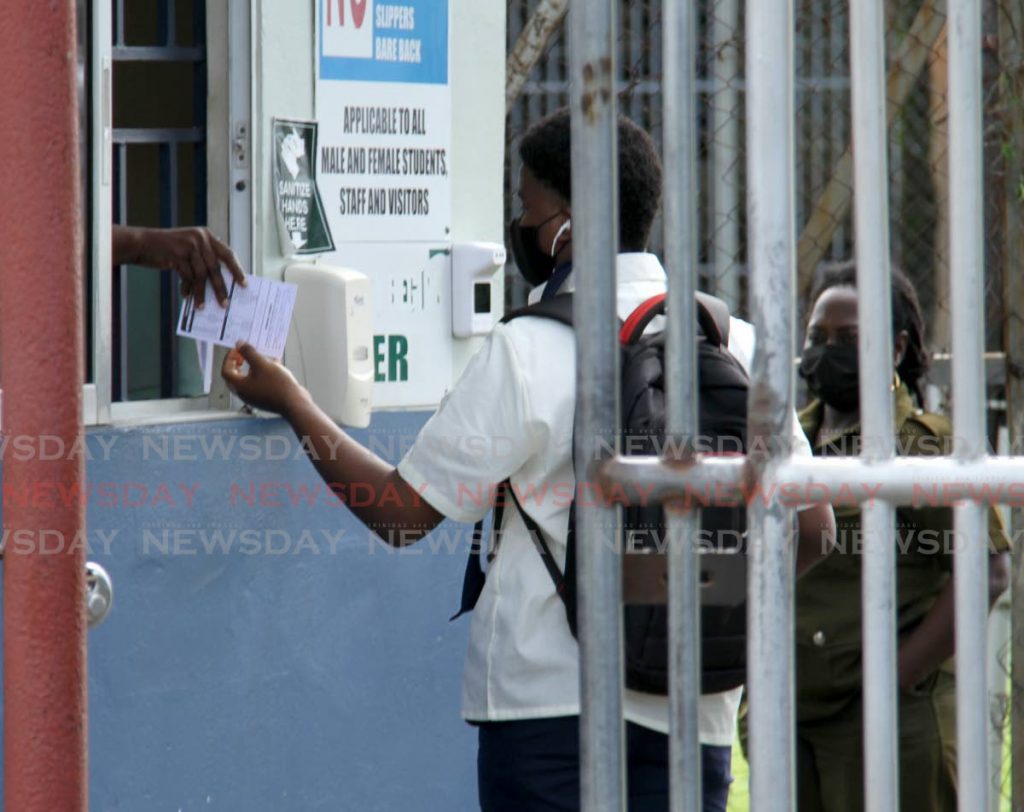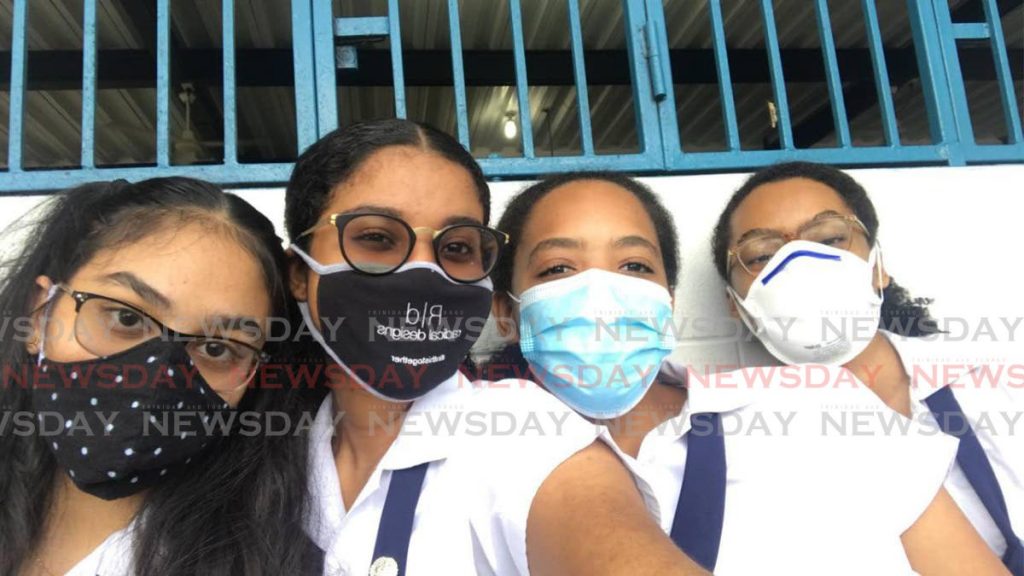Upper form students turnout good at Presbyterian schools

Two weeks after physical school reopened for vaccinated students in forms four to six, the attendance rate and, at times, access to education of denominational secondary schools, at least in those run by the Presbyterian church, seem to be much better than at government schools.
One teacher at a government secondary school in east Trinidad said the school’s forms four and five population is about 100. However, over the past two weeks, five students and about 30 teachers have attended school. And most teachers teach both the upper and lower schools.
“Because I teach two subjects in both the upper and lower schools, I am in school every day to teach one student for each class.”
She said the one other student who was vaccinated did not attend school because she lives far away and, seeing that the school maxis are not operational, the child could not afford to travel to school.
The one child in her form four class did not attend online school or collect any work packages for their entire form three year. In addition, they do not recall a lot of the form two work.
“I must say, she is trying and she is doing work so I don’t foresee any problems. So, I’m teaching her my scheme (form four work) and, as things she doesn’t know come up, I do a mini lesson and give her some resources. I can’t do a full lesson because then I wouldn’t finish my scheme and when other students come out, that would keep them back.”
While in school, she can not be online so she has been posting asynchronous work for her students who were not in physical school. She records herself teaching lessons as she would have while online – creating and going through power point slides, showing and explaining videos, explaining examples, and more – and posts it on the school’s online platform.
She also prepares packages for students who are not online.
She said it takes the same effort, time and resources to teach one child or 30 children face-to-face. In-class lessons are different to a virtual lesson with different styles of teaching and different types of activities. The same is true for the work packages.
She usually makes all those preparations late into the week nights and on weekends, leaving very little time for her family life.
“A parallel system, the way they want it to run, it can not work, and the government will not put a vaccine mandate. The policy is you have to vaccinate your child to send them to school so, as far as I’m concerned, if I don’t post work on the online platform for your unvaccinated child, I’m not denying their right to an education. You (the parent) are doing that. Because the education is happening in a classroom in the school.”

She also does online classes with forms one to three students.
She said since the school’s internet tends to crash if too many people log in at the same time, she has to drive for an hour to go home so she could teach her lower form classes. So, on some days she has to miss those classes and would have to, again, make videos and prepare asynchronous work for those students.
“It’s very exhausting. And the ministry is basically saying if I do face-to-face I don’t need to do anything online live. Because the workload is so much now, and it is taking a toll, I think a lot of teachers are refusing to do anything online.
“To tell you the truth I’m tempted to do it too because it’s really hard and I’m still working for a 2012 salary. But I dotish. That’s the only reason I can come up with that I’m doing it – teaching online live, in school, sending asynchronous work, doing quizzes, recording classes on a weekend, and doing packages! Because clearly I am dotish.”
“I mean, I understand why parents may not want to get their children vaccinated and that’s the only reason I’m making the effort. Can you imagine what teachers who have children are going through, or those with elderly parents or sick family members?”
One positive part of the situation is that her two students love having her to themselves since they get personal attention, they do not feel awkward about asking questions if they do not understand, and can go at their own pace instead of trying to keep up with other students. One student said they wished none of the other students got vaccinated so things could stay at they are.
The teacher added that she was looking forward to see her form two class who she taught throughout form one but never met in person. And she let them know there would be no live online classes once physical school resumed.
“If even one of my form ones and twos come out, I will not be able to even do asynchronous for those at home. I will not have the time to do it. In this case, the needs of the few will outweigh the needs of the many.”
She stressed that she enjoyed the tools on the various online platforms such as self-correcting quizzes and being able to sharing links to videos or documents. Even though they generally require more work than face-to-face classes, she believed they should continue to be used as a support since they are affective.
Another teacher from a government school in central Trinidad said about 50 of the 300 forms four, five and six students returned to physical school. She personally has five students in her physical class.
For the first week, teachers left asynchronous work for those who could not attend physical classes and did not have any online classes.
“However, our school redid a time table for us where the forms four and fives were coming out on alternating days so we could actually have more time to teach those who are home online live.
“Of course, it’s more difficult on the teachers, teaching the same thing twice, preparing the same lesson in different ways for online and physical classes, and ensuring we have quality content for both media.”
She said it was taxing on her, especially since there are more teachers than classrooms, so, on many days, she has to drive home to teach a live online class, then return to work to teach face-to-face.
She said when the lower forms return to school, they may suffer because if teachers had to choose, they would most likely prioritise the upper school. However, if enough of the lower school comes out, they may decide to do only asynchronous work with those who do not attend physical classes.
She said the many changes and uncertainties are causing a lot of anxiety in teachers, and students who have difficulties learning independently are upset and stressed.
“I just feel sorry for the children and the loss of contact time with their teachers. It’s not their fault they’re not vaccinated. It’s up to their parents.
“It will hinder their education and widen the educational gap. There’s already this huge socioeconomic divide that we thought would have been bridged with the distribution of devices by the ministry. Then this happens and you’re dividing children.
“Again, it’s going to be the lower socioeconomic bracket of students that suffer – those who can’t afford to come out to school, who have to chose between purchasing a data package or buying books and uniforms and travelling money to send their child out to school.”
She suggested the Ministry of Health undergoes more educational campaigns about vaccines targeting parents, and the Ministry of Education reconsiders sending younger students to physical classes.
She believed government should wait a while for the upper school to settle down and ensure the initiative is successful before bringing in the lower school. Further more, she believed the reentry of the lower forms should be staggered.
“I understand the government just wants people to get vaccinated but they don’t have to use children as pawns in this case.”
Things have been very different for schools run by denominational boards, including the Presbyterian Secondary Schools’ Board of Education, which is in charge of Hillview College, Tunapuna; Naparima College, San Fernando; Naparima Girls' High School, San Fernando; St Augustine Girls' High School, St Augustine; and Iere High School, Siparia.
General secretary of the board, Gary Samai, told Sunday Newsday with about 300 upper school students at each of its five schools, the average attendance in each form is about 70 per cent.
He said most of the schools have access to equipment and the students’ parents are adamant about their children getting the Pfizer covid19 vaccine so they could return to physical classes.
Through generous donations, all the students have laptops, and since the schools have dependable wifi access and video cameras, those not in physical class can live stream their classes.
“Parents are willing to participate in this virtual/ face-to-face type of arrangement. So even if a child’s family member may have contracted covid and they would have been placed in quarantine, the child does not lose the opportunity to learn because of the capabilities and good planning of the principals of the schools.”
He said most of the schools are using a rotation system where different forms attend school on different days so there would be enough physical space to social distance the students. On the days there are no physical classes, work would be assigned and there would be asynchronous learning.
The continuation of asynchronous learning is also necessary because, while all children have devices, not all have wifi at home. In this way, they can learn and do their work whenever they get access to the internet.
“Our teachers go out of their way for their students. They would pre-record classes and work well beyond that 2.30 pm hour to ensure that the children benefit.”
Samai said the schools are now in the planning stages on how things would work when the forms one to three students return to physical school, increasing the population to over a thousand students per school. There is concern about how they will all fit with social distancing.
“Strategic planning is involved but you have to have buy-in by your teaching and auxiliary staff. You need to have a passion for the institution that you serve as well as resources."


Comments
"Upper form students turnout good at Presbyterian schools"